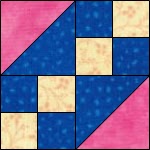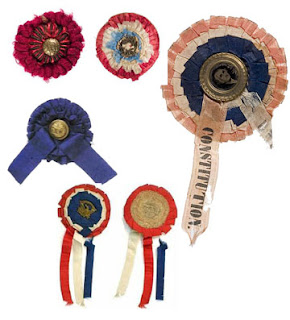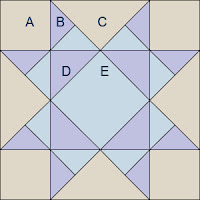Missouri Star by Gloria Clark
Missouri Star can remind us of Mattie Lykins Bingham who represents well the torn loyalties of the people of Missouri. Wife of two Union sympathizers, she maintained her Confederate allegiances to her death in 1890.
Mattie about 1875.
In early May, 1861, Confederates seized arms in Kansas City and gathered near the St. Louis Arsenal intending to confiscate weapons there. Federal troops raided their camp and marched the captured Confederates through St. Louis inspiring violence from rebel bystanders. The St. Louis Riots increasing hostilities between the country residents with roots in Kentucky and Tennessee and the city dwellers, recent immigrants from Germany and Ireland. The Union armies might control the cities but no one could control Missouri's rural areas.
Mattie, born in Kentucky in 1824, married Kansas Citian Johnston Lykins, a former missionary to the Kansas tribes, who made a good deal of money in real estate. Although her banker husband was a Unionist in a Union town, Mattie was an outspoken Southron, to use a period word.
Missouri remained a Union state. In 1863 the Federal forces governing Kansas City banished her to the country for the duration. She was suspected of spying for Confederate guerillas, particularly blamed for their deadly raid on the Union town of Lawrence, Kansas. Kansas Citians told of her waving to her husband on the shore as the riverboat took her to her exile, calling to him to take care of his laundry.
After the War Mattie returned to Kansas City and became the woman behind local campaigns to remember The Lost Cause. She organized Confederate burial grounds, an orphanage and an old soldiers' home.
A weathered angel watches over children
at a school on the site of
Mattie's Confederate Orphanage in Kansas city.
After Lykins's death in 1878 she married former Union officer George Caleb Bingham. Bingham, a well-known artist, painted "Order Number Eleven," depicting the banishment of Southern sympathizers from their homes in 1863.
A detail of Bingham's Order Number Eleven.
Get your applique needles ready,
we'll be doing a quilt pattern named Order Number Eleven in a few months.
Mattie left a will directing that all Bingham's paintings be sold to fund the Missouri Confederate Home. She's buried between the graves of her two husbands at Kansas City's Union Cemetery.
Missouri Star is #2154 in BlockBase and my Encyclopedia of Pieced Quilt Patterns. The name was given to this star by the Nancy Cabot column of the Chicago Tribune in 1933.
Cutting an 8" Finished Block
A Cut 4 squares 2-1/2" light.
B Cut 2 squares of medium and 2 squares of dark each 3-1/4". Cut each into 4 triangles with 2 cuts. You need 4 triangles of each.
(See below of another idea for these triangles if you are working small.)
C Cut 1 square 5-1/4" light. Cut it into 4 triangles with 2 cuts. You need 4 triangles.
D Cut 2 dark squares 2-7/8". Cut each into 2 triangles with 1 diagonal cut. You need 4 triangles.
E Cut 1 medium square 3-3/8".
Another idea for the star points B if you are working small. Instead of using the measurements for B cut 8 more triangles the same size as D but fussy cut them across a stripe. (Make yourself a transparent template from one of your D pieces so you get the stripe right.)
The beneficiary of Mattie's will:
The Confederate Home of Missouri
Read more about the remarkable Mattie Lykins Bingham in my book on the Civil War on the Missouri/Kansas border: Borderland in Butternut and Blue.
Click here:
And read more about George Caleb Bingham by clicking here:
Rose Ann Findlen has published a new biography of Mattie through the Jackson County (Missouri) Historical Society. Click here to read about Missouri Star: The Life and Times of Martha A. "Mattie" (Livingston) Lykins Bingham:
Woman with a reading glass
Mattie's been in the news in Kansas City lately. A very lucky woman bought an unsigned portrait of a woman in a Missouri antique shop. It looks just like Mattie to me, and many people believe it to be a lost Bingham painting of his third wife.
Missouri Star
by Becky Brown





























































